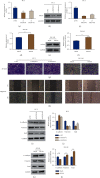FSCN1 Promotes Glycolysis and Epithelial-Mesenchymal Transition in Prostate Cancer through a YAP/TAZ Signaling Pathway
- PMID: 35815268
- PMCID: PMC9259215
- DOI: 10.1155/2022/6245647
FSCN1 Promotes Glycolysis and Epithelial-Mesenchymal Transition in Prostate Cancer through a YAP/TAZ Signaling Pathway
Retraction in
-
Retracted: FSCN1 Promotes Glycolysis and Epithelial-Mesenchymal Transition in Prostate Cancer through a YAP/TAZ Signaling Pathway.Evid Based Complement Alternat Med. 2023 Oct 4;2023:9870758. doi: 10.1155/2023/9870758. eCollection 2023. Evid Based Complement Alternat Med. 2023. PMID: 37829643 Free PMC article.
Abstract
Objective: The aim of the study is to investigate the role and possible mechanism of fascin-1 (FSCN1) in the invasion, migration, glycolysis, and epithelial-mesenchymal transition (EMT) of prostate cancer.
Methods: Real-time quantitative polymerase chain reaction (qRT-PCR) was utilized to determine the mRNA expression level of FSCN1 in prostate cancer tissues and prostate cancer cells PC-3 and DU145. The transwell and the scratch test were applied to detect the invasion and migration abilities of cells, respectively. A metabolic assay was used for measuring the glucose consumption, lactate production, and the extracellular acidification rate (ECAR) in cells; western blot was used for checking FSCN1, EMT, and yes-associated protein/transcriptional co-activators with the PDZ-binding motif (YAP/TAZ) signaling pathway-related protein expression level in cells or tissues.
Results: FSCN1 was significantly highly expressed in prostate cancer tissues and cells. On the one hand, interference with the expression of FSCN1 could inhibit the invasion, migration, EMT, and glycolysis of prostate cancer cells. On the other hand, overexpression of FSCN1 promoted the invasion, migration, EMT, and glycolysis of prostate cancer cells. Besides, further mechanistic studies revealed that FSCN1 could activate the YAP/TAZ signaling pathway in prostate cancer cells.
Conclusion: FSCN1 promotes invasion, migration, EMT, and glycolysis in prostate cancer cells by activating the YAP/TAZ signaling pathway. FSCN1 may be used as a biomarker for the diagnosis or treatment in prostate cancer.
Copyright © 2022 Minghui Li et al.
Conflict of interest statement
The authors declare that they have no conflicts of interest.
Figures




Similar articles
-
Retracted: FSCN1 Promotes Glycolysis and Epithelial-Mesenchymal Transition in Prostate Cancer through a YAP/TAZ Signaling Pathway.Evid Based Complement Alternat Med. 2023 Oct 4;2023:9870758. doi: 10.1155/2023/9870758. eCollection 2023. Evid Based Complement Alternat Med. 2023. PMID: 37829643 Free PMC article.
-
ETS (E26 transformation-specific) up-regulation of the transcriptional co-activator TAZ promotes cell migration and metastasis in prostate cancer.J Biol Chem. 2017 Jun 2;292(22):9420-9430. doi: 10.1074/jbc.M117.783787. Epub 2017 Apr 13. J Biol Chem. 2017. PMID: 28408625 Free PMC article.
-
FSCN1 Promotes Epithelial-Mesenchymal Transition Through Increasing Snail1 in Ovarian Cancer Cells.Cell Physiol Biochem. 2018;49(5):1766-1777. doi: 10.1159/000493622. Epub 2018 Sep 19. Cell Physiol Biochem. 2018. PMID: 30231243
-
YAP/TAZ Signaling as a Molecular Link between Fibrosis and Cancer.Int J Mol Sci. 2018 Nov 20;19(11):3674. doi: 10.3390/ijms19113674. Int J Mol Sci. 2018. PMID: 30463366 Free PMC article. Review.
-
A Potential Role of YAP/TAZ in the Interplay Between Metastasis and Metabolic Alterations.Front Oncol. 2020 Jun 11;10:928. doi: 10.3389/fonc.2020.00928. eCollection 2020. Front Oncol. 2020. PMID: 32596154 Free PMC article. Review.
Cited by
-
Potential Roles of YAP/TAZ Mechanotransduction in Spaceflight-Induced Liver Dysfunction.Int J Mol Sci. 2023 Jan 22;24(3):2197. doi: 10.3390/ijms24032197. Int J Mol Sci. 2023. PMID: 36768527 Free PMC article. Review.
-
Comparative efficacy of radical prostatectomy and radiotherapy in the treatment of high-risk prostate cancer.Technol Health Care. 2024;32(6):4671-4679. doi: 10.3233/THC-240910. Technol Health Care. 2024. PMID: 39093097 Free PMC article.
-
Targeting FSCN1 with an oral small-molecule inhibitor for treating ocular neovascularization.J Transl Med. 2023 Aug 18;21(1):555. doi: 10.1186/s12967-023-04225-0. J Transl Med. 2023. PMID: 37596693 Free PMC article.
-
Retracted: FSCN1 Promotes Glycolysis and Epithelial-Mesenchymal Transition in Prostate Cancer through a YAP/TAZ Signaling Pathway.Evid Based Complement Alternat Med. 2023 Oct 4;2023:9870758. doi: 10.1155/2023/9870758. eCollection 2023. Evid Based Complement Alternat Med. 2023. PMID: 37829643 Free PMC article.
-
High-fat diet promotes tumor growth in the patient-derived orthotopic xenograft (PDOX) mouse model of ER positive endometrial cancer.Sci Rep. 2023 Oct 2;13(1):16537. doi: 10.1038/s41598-023-43797-1. Sci Rep. 2023. PMID: 37783734 Free PMC article.
References
Publication types
LinkOut - more resources
Full Text Sources
Miscellaneous

